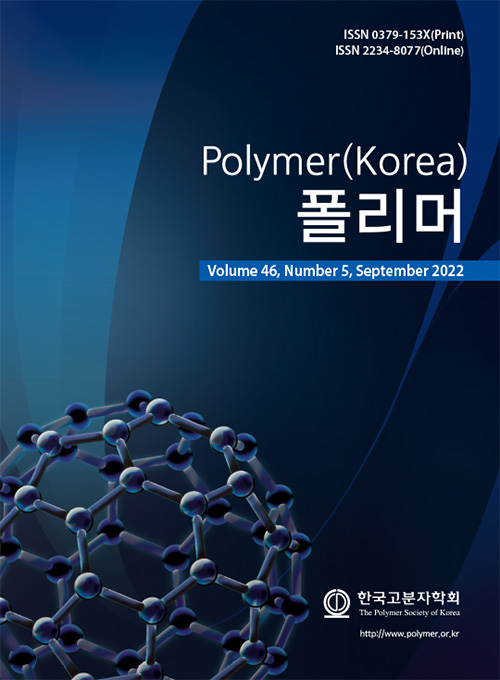- Thermal and Mechanical Properties of Antimicrobial Poly(lactic acid) Composites
Department of Chemical Engineering, Kunsan National University, Daehakro 558, Kunsan, Chonbuk 54150, Korea
*Bestech Incorporated Co., Dongkunsanro 942, Seosumyeon, Kunsan, Chonbuk 54051, Korea- 항균 폴리유산 복합재료의 열적 및 기계적 물성
군산대학교 공과대학 화학공학과, *(주)베스텍
Reproduction, stored in a retrieval system, or transmitted in any form of any part of this publication is permitted only by written permission from the Polymer Society of Korea.
Antimicrobial plastics containing benzalkonium chloride, 1,2-hexanediol/1,2-octanediol 1:1 mixture, and copper sulfide (CuS) powder biocides added alone or all together to a poly(lactic acid) composite containing 10 wt% of talc were manufactured by a twin-screw extruder and were injected into specimens for physical properties. In the both cases including the 1:1 mixture of 1,2-hexanediol and 1,2-octanediol or all three biocides, the heat resistance of the antibmicrobial poly(lactic acid) composite was slightly decreased. However, both benzalkonium chloride and copper sulfide showed its some improvement. Although the tensile strength didn’t change by the addition of biocide, the tensile modulus was slightly decreased and the elongation at break was greatly decreased. Flexural strength also decreased with the addition of biocide, but flexural modulus slightly increased. Notched Izod impact strength showed a tendency to decrease with a slight difference depending on the biocide. The antibacterial performance was excellent in the cases containing benzalkonium chloride, but was poor in those containing the 1,2-alkanediol mixture or copper sulfide. The antifungal performance was the best when all three biocides were added, rather than those used alone. The sterilizing power of influenza A virus was excellent as 99.998% when all three were added. Mixing biocides showed a synergistic effect on the antimicrobial performance of poly(lactic acid) composites, but more efforts such as evaluating the effects of biocides on the human body are expected to contribute to securing the stability of poly(lactic acid) products.
탈크를 10 wt% 포함하는 폴리유산 복합재료에 살생제로 벤잘코늄염화물, 1,2-헥산디올과 1,2-옥탄디올 1:1 혼합물 및 황화구리(CuS) 분말을 단독 또는 혼합 첨가한 항균 플라스틱을 이축 압출기로 제조하였고 물성 시편으로 사출하였다. 1,2-헥산디올과 1,2-옥탄디올 1:1 혼합물과 3가지를 모두 포함하는 경우에서 항균 폴리유산 복합재료의 내열성은 약간 감소하였으나 벤잘코늄염화물과 황화구리는 약간 상승시켰다. 살생제 첨가에 의해 인장강도는 거의 변하지 않았으나 인장탄성률은 약간 감소하였고 신율은 크게 감소하였다. 살생제 첨가로 굴곡강도는 감소하였고 굴곡탄성률은 약간 증가하였다. 노치드 Izod 충격강도는 살생제에 따라 약간의 차이는 있지만 모두 감소하였다. 항박테리아 성능은 벤잘코늄염화물을 포함하는 경우들에서 우수하였으나 1,2-알칸디올 혼합물 또는 황화구리를 포함한 폴리유산 복합재료에서는 나빴다. 항진균 성능은 살생제를 단독 사용한 것들 보다 세 가지 모두 첨가한 경우가 가장 우수하였다. 인플루엔자 A 바이러스의 살균력도 세 가지 모두 첨가한 경우가 99.998%로 우수하였다. 본 연구에선 살생제를 혼합하여 폴리유산 복합재료의 항균성능에서 상승효과를 보였으나 인체에 대한 영향 평가 등 보다 많은 노력이 플라스틱 제품의 안정성 확보에 기여할 것으로 판단된다.
Keywords: poly(lactic acid), benzalkonium chloride, 1,2-alkanediols, copper sulfide, antimicrbial activity.
- Polymer(Korea) 폴리머
- Frequency : Bimonthly(odd)
ISSN 0379-153X(Print)
ISSN 2234-8077(Online)
Abbr. Polym. Korea - 2022 Impact Factor : 0.4
- Indexed in SCIE
 This Article
This Article
-
2022; 46(5): 684-694
Published online Sep 25, 2022
- 10.7317/pk.2022.46.5.684
- Received on Jun 9, 2022
- Revised on Jul 22, 2022
- Accepted on Aug 1, 2022
 Correspondence to
Correspondence to
- Seogjun Kim
-
Department of Chemical Engineering, Kunsan National University, Daehakro 558, Kunsan, Chonbuk 54150, Korea
- E-mail: sjkim@kunsan.ac.kr










 Copyright(c) The Polymer Society of Korea. All right reserved.
Copyright(c) The Polymer Society of Korea. All right reserved.